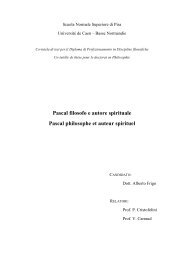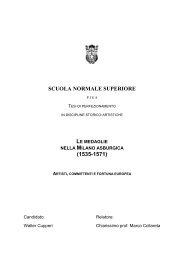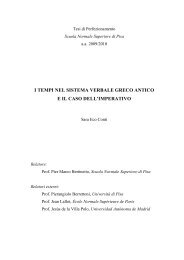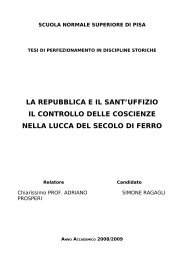CATULLUS 68 - Scuola Normale Superiore
CATULLUS 68 - Scuola Normale Superiore
CATULLUS 68 - Scuola Normale Superiore
Create successful ePaper yourself
Turn your PDF publications into a flip-book with our unique Google optimized e-Paper software.
esemble a communis opinio. 171 Thomson has only discussed part of the problem in the introduction to his<br />
edition of 1978, and in the table of manuscripts and the stemma in both his editions (the introduction to his<br />
1997 edition contains no section on the recentiores at all). 172 There clearly remains room for scepticism here,<br />
as has been pointed out by M.D. Reeve in a memorable review of Thomson’s 1978 edition: as he put it,<br />
“suspicious natures may consider it a little too neat that out of 100-odd manuscripts all the rest should derive<br />
from the only three that antedate 1395.” 173 It would be possible to prove this right or wrong with reference to<br />
the readings of OGR and to those of the recentiores – but nobody has done so, nor is it difficult to see why.<br />
We are dealing with over 100 heavily interpolated manuscripts; drawing up a full stemma may not be exactly<br />
an “impossible task”, as was suggested by McKie, but it is certainly not something that is easily done. 174 In<br />
the absence of such an investigation one has to treat the recentiores with caution. They appear to contain<br />
very little that is not found in OGR and that cannot easily be attributed to conjecture and corruption. While<br />
only a thorough study could bring certainty, on the basis of the experience of others and myself with the<br />
recentiores I believe that the text of all of them may very well be based on OGR, especially on R, but on<br />
occasion they may show the influence of older manuscripts from the same tradition, such as the prearchetype<br />
V. One salient case is line 3 of poem 34, which is missing in OGR but is found in MS 106 (the<br />
Vatican codex Urbinas lat. 812) and in the first Aldine edition of 1502. It is first attested in 1496 in the<br />
commentary of Palladius, who claims to have found it ‘in uetustiore exemplari’, ‘in an older copy of the<br />
text’. There may well be other cases of this type. 175 However, it is clear by all accounts that Catullus’<br />
Renaissance readers were prepared to make a big effort to correct his text, so if we find an attractive textual<br />
variant in a manuscript from this period, the default assumption that we should make is that it is probably a<br />
conjecture or a mistake. In Catullus <strong>68</strong> the recentiores certainly offer no variants that cannot be explained<br />
like this.<br />
171<br />
Mynors 1958: viii solved the problem in a rather cavalier way by asserting that “[q]uod ad ceteros codices attinet, …<br />
omnes a codicibus OGR originem aut duxerunt aut, quod nobis idem ualet, duxisse possunt”. Goold 1958: 95<br />
commented that “Mynors’ edition solves this problem once and for all by providing enough ms readings to prove Hale’s<br />
hitherto unsubstantiated claim (TAPA 53 [1922] 111) that ‘all the manuscripts except O G R are derived from these<br />
three, and … we may and must cut off the whole web below the manuscripts O G R.’ ” Mynors has certainly not proven<br />
this, and his words indicate that he did not care whether or not it was the case; he simply believed that in any case it was<br />
possible to base an edition on OGR, since they enabled one to reconstruct the lost Codex Veronensis.<br />
172<br />
Introduction: Thomson 1978: 33-41. Table of manuscripts: Thomson 1978:44-63 and 1997: 72-91. Stemma:<br />
Thomson 1978: 69 and 1997: 93.<br />
173<br />
Reeve 1980: 179f.<br />
174<br />
McKie 1977: 28.<br />
175<br />
Until the last quarter of the 20th century, the recentiores found champions on the European continent such as<br />
Francesco Della Corte (1951: 3-191) and Catullus’ editors for the Teubner series, Schuster, Bardon and Eisenhut. Della<br />
Corte’s position was demolished by Zicàri (1952), while the Teubner editors disbelieved Hale’s stemma and treated<br />
Lachmann’s Datanus (4) as an independent witness well after it had been demonstrated by Ullman (1960: 1052f., cfr.<br />
Thomson 1978: 35-41) that this codex was a copy of the Riccardianus (31).<br />
78






